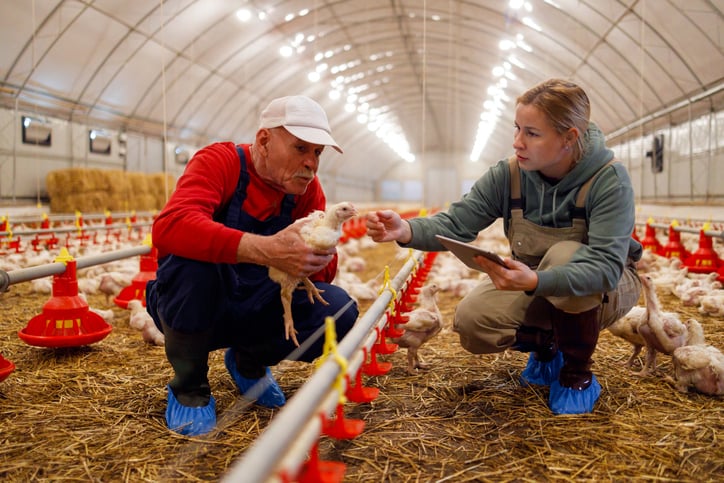What is a reportable disease?
In Western Australia (WA), the Biosecurity and Agriculture Management Act 2007 requires that certain diseases must be reported to a Biosecurity and Agriculture Management Act 2007 Inspector if they are known or suspected to be present.
If you know or suspect that an animal is affected by a reportable disease, there is a legal obligation to notify a DPIRD Inspector as soon as is reasonably possible.
DPIRD Diagnostic Laboratory Services waive laboratory fees for investigations into cases of suspected reportable diseases, and subsidies are available to support veterinary investigations.
Which diseases must be reported?
Diseases of significance to WA that must be reported are listed below and on the Reportable animal diseases - Western Australia list. These diseases, and details of their legal status, are also listed on the Western Australian Organism List (WAOL).
- Anthrax
- Australian bat lyssavirus
- Borna disease
- Bluetongue
- Crimean-Congo haemorrhagic fever
- Chrysomya bezziana (Old World screwworm)
- Cochliomyia hominivorax (New World screwworm)
- Echinococcus multilocularis
- Ehrlichia ruminantium (heartwater)
- Epizootic haemorrhagic disease
- Foot-and-mouth disease
- Francisella tularensis (tularaemia)
- Getah
- Japanese encephalitis
- Leishmania spp.
- Liver fluke
- Louping ill
- Malignant catarrhal fever (wildebeest-associated)
- Mycobacterium bovis
- Mycobacterium caprae
- Mycobacterium tuberculosis
- Paratuberculosis (Johne’s disease)
- Rabies
- Rift Valley fever
- Rinderpest
- Tick borne encephalitis
- Transmissible spongiform encephalopathies (bovine spongiform encephalopathy, chronic wasting disease, feline spongiform encephalopathy, scrapie)
- Trichinella spp.
- Trypanosoma cruzi (Chagas disease)
- Trypanosoma evansi (surra)
- Trypanosomosis (tsetse fly associated)
- Vesicular stomatitis
- Warble-fly (warble-fly myiasis)
- West Nile virus
- Anaplasma marginale (bovine anaplasmosis) in tick free areas
- Babesia bovis, B. bigemina or B. divergens (bovine babesiosis) in tick free areas
- Enzootic bovine leucosis
- Bovine virus diarrhoea (type 2)
- Brucella abortus
- Jembrana disease
- Lumpy skin disease
- Foot-and-mouth disease
- Mycoplasma mycoides subsp. mycoides SC (contagious bovine pleuropneumonia)
- Theileria parva (East Coast fever) or T.annulata (Mediterranean theileriosis)
- Haemorrhagic septicaemia ( Pasteurella multocida serotypes 6:b and 6:e)
- Taenia saginata (cysticercus bovis)
- Brucella melitensis
- Contagious agalactia
- Chlamydophila abortus (enzootic abortion of ewes, ovine chlamydiosis)
- Virulent footrot
- Jaagsiekte
- Maedi-visna
- Mycoplasma capricolum subsp. capripneumoniae (contagious caprine pleuropneumonia)
- Nairobi sheep disease
- Peste des petits ruminants
- Salmonella abortus-ovis
- Sheep pox or goat pox
- Wesselsbron
- Psoroptes ovis (sheep scab)
- African horse sickness
- Babesia caballi, B. equi, or Theileria equi (equine piroplasmosis)
- Burkholderia mallei (glanders)
- Eastern, western or Venezuelan equine encephalomyelitis viruses
- Equine arteritis
- Equine encephalosis
- Equine herpesvirus-1 (EHV-1)
- Equine infectious anaemia
- Equine influenza
- Hendra virus
- Histoplasma farciminosum (epizootic lymphangitis)
- Neorickettsia risticii (Potomac fever)
- Salmonella abortus-equi
- Taylorella equigenitalis (contagious equine metritis)
- Trypanosoma equiperdum (dourine)
- African swine fever
- Aujeszky’s disease (pseudorabies virus)
- Brucella suis
- Bungowannah virus
- Classical swine fever
- Influenza A viruses in swine
- Menangle
- Nipah
- Porcine epidemic diarrhoea
- Porcine reproductive and respiratory syndrome virus
- Seneca Valley virus (Senecavirus A)
- Swine vesicular disease
- Taenia solium (porcine cysticercosis)
- Transmissible gastroenteritis
- Vesicular exanthema
- Post-weaning multi-systemic wasting syndrome
- Teschovirus encephalomyelitis
- Anatid herpesvirus-1
- Avian metapneumovirus (turkey rhinotracheitis)
- Duck virus hepatitis
- Infectious bursal disease virus (very virulent and exotic antigenic variant forms)
- Influenza A viruses in birds
- Mycobacterium avium (avian tuberculosis) in birds
- Mycoplasma iowae
- Newcastle disease virus (virulent)
- Salmonella Enteritidis in poultry
- Salmonella Gallinarum (fowl typhoid)
- Salmonella Pullorum (pullorum disease)
- Brucella canis
- Camelpox
- Devil facial tumour disease
- Middle East respiratory syndrome
- Pseudogymnoascus destructans in bats (white nose syndrome).
The department provides subsidies for disease investigations where the signs are unusual or affecting several animals in a group. Ask your veterinarian about the Significant Disease Investigation Program.
Why is reporting so important?
Early recognition and reporting of disease is one of the most important factors influencing the control of disease and the reduction of its impact on industry and the community.
· Fast detection enables rapid investigation, control, and eradication wherever possible.
· Reporting also supports continued critical export market access by providing evidence of the absence of specific animal diseases.
There are several reasons why a disease may be included on the reportable disease list. The disease may be:
· exotic to Australia
· present in Australia but exotic to WA
· subject to a control or eradication program
· of significance for export/trade
· have the potential to cause significant socio-economic impacts
· zoonotic (can affect humans).
What happens after a disease is reported?
The action that follows a reportable disease report varies according to the level of suspicion of disease and the disease involved. The department will work with the producer to investigate when there is suspicion of the disease and confirm whether it is an endemic (disease known to be present in WA) non-reportable disease or a reportable disease.
If a reportable disease is confirmed, for emergency diseases of major significance such as foot-and-mouth disease or bovine spongiform encephalopathy there would be an emergency response aimed at eradication. The diagnosis of some reportable diseases may result only in advice being provided to the producer to manage the disease.

